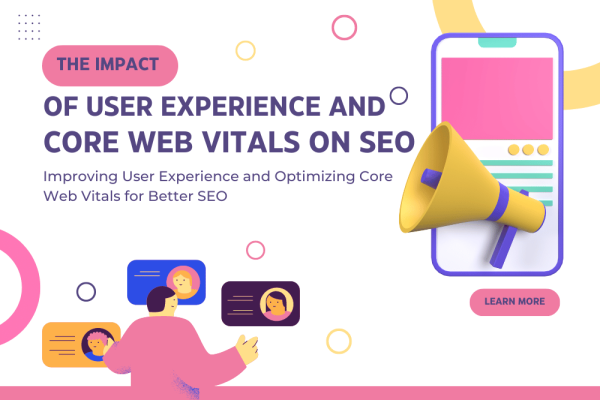The Impact of User Experience and Core Web Vitals on SEO
Back in 2021, Google rolled out Core Web Vitals, which put user experience front and center for SEOs. Now, website teams must optimize for these essential metrics to retain and convert more visitors.
These three primary metrics measure your site's loading speed and visual stability. They're measured using "field data" from Chrome browsers over a 28-day period.
Page load speed
Traditionally, page speed has been one of the main concerns of SEOs and web developers. But with the Google page experience update and Core Web Vitals becoming ranking factors, there’s more to consider than just how fast a site loads. It’s also important to focus on user experience, as it affects whether users find the content they want to read or click through to other pages.
While there are many tools to measure and analyze a website’s performance, the easiest way to see how you’re doing is by using Google’s Page Speed Insights tool, which can be found in the Experience tab in Search Console. This tool will tell you which URLs have a good, needs improvement, or poor experience and provide suggestions on how to improve. However, it is important to note that the results from this tool are based on lab data rather than field data, and it is not uncommon for differences in lab and field data to result in a different score.
Another tool you can use to get a better sense of how your page speed is performing is the Core Web Vitals report (also in the Experience tab in Search Console). This will give you the results from field data over 28 days for three specific metrics: largest contentful paint, first input delay, and cumulative layout shift.
The results from the Core Web Vitals report will show you whether your page meets the standards set by Google. To receive the biggest rankings boost, your pages need to have at least a “good” experience in all three metrics. For example, if you have a good Largest Contentful Paint but a bad First Input Delay and an even worse Cumulative Layout Shift, your site is not going to rank highly.
Mobile-friendliness
As the use of mobile phones for web browsing continues to grow around the globe, it is important that websites be optimized for viewing on mobile devices. This is why Google has made mobile-friendliness a ranking factor in their search engine results, and it is a critical aspect of SEO to consider when developing a strategy for your website.
In order to be considered mobile-friendly, your site must meet a number of requirements including having responsive design that adjusts to fit the screen size of a user’s device, using HTML rather than Flash, avoiding horizontal scrolling and having text large enough for users to read on their mobile devices. Additionally, websites should test their mobile-friendliness by using Google’s free Mobile-Friendly Test tool and make any necessary adjustments to improve the overall quality of their site.
Mobile-friendliness is also a key component in Google’s Core Web Vitals metrics, which are a new set of page rank signals that focus on the overall user experience. Unlike old Google ranking factors that focused on security and device compatibility, Core Web Vitals (CWV) include measures like First Input Delay (FID), Interaction to Next Paint (INP), and Cumulative Layout Shift (CLS) that are heavily influenced by user experience and have direct impact on search rankings.
While most businesses understand that they need to have a mobile-friendly website, many are still behind the curve in meeting best practices. In fact, when we recently hosted a webinar with Rebel Mouse on this topic, she noted that 77% of sites fail to meet CWV standards and only 10% have made any improvement since they were introduced in 2021.
When optimizing for mobile, it is important to look at both lab and field data in the Page Speed Insights tool, to get a more complete picture of your site’s performance. While the lab data is great for debugging and testing any changes you may be making to your site, the field data shows how a page actually performed on Chrome users’ devices over a 28-day period, so this is a more accurate representation of real-world performance.
Overall user experience
As the search engine industry has evolved, so too have web users. Today, a website that doesn’t meet user experience best practices isn’t going to rank well in the search engines. That’s why boosting your page speed and overall user experience should be your priority. By focusing on these metrics, you’ll improve engagement and conversion rates while increasing visibility.
Since the 2021 update, Google’s algorithm has been geared toward a more user-centric approach with page experience ranking factors. These Core Web Vitals metrics include Largest Contentful Paint (LCP), First Input Delay (FID) and Cumulative Layout Shift (CLS).
LCP measures the time it takes for the main content on a web page to load, which includes both media and text. This metric is important because it can affect the perceived loading speed of a site. A slow site can cause visitors to become frustrated and leave before the site has loaded, which may lead to a higher bounce rate.
FID measures the time it takes for the browser to receive an input from the user’s computer and respond to it. Ideally, this should occur in less than 100 ms. A long TTFB could result in poor user experience.
CLS is a measure of the visual stability of a page, which looks at how often elements on the screen shift and how far they move as the page loads. Optimizing for this metric can prevent users from clicking on things they don’t want to see, or getting lost as the page scrolls down.
The good news is that there are many tools available for measuring these metrics, and they can be used to identify areas of improvement. Start by comparing your site’s performance to those of competitors. You can also use Real User Monitoring (RUM) tools to collect field data for your site and correlate it with your key business metrics.


